Antoni de Moragas Gallissà
Barcelona, 1913 — 1985
Antoni de Moragas Gallissà was born, studied, and worked as an architect in Barcelona, at a time when postwar Spain remained culturally and industrially distant from the modern world. Aware of that gap, he actively sought out ways to engage with contemporary thinking—through debate, creative practice, and the formation of collaborative platforms.
In 1949, he founded Club 49, a meeting point for the international avant-garde. By 1957, the initiative evolved into Grupo R, a formal collective through which he helped drive a major architectural renewal in Barcelona. In 1960, he co-founded ADI-FAD (Spain’s Industrial Design Association) and served as its first president, laying the groundwork for modern design in Spain alongside key figures like Miguel Milà, André Ricard, and Rafael Marquina.
This environment of critical thinking and experimentation shaped not only his philosophy but also his work. His design language was rooted in functionality yet enriched with Nordic influences—particularly from Alvar Aalto, with whom he had a close relationship in the 1950s. From this fusion of rational structure and organic warmth came designs with a deeply human sensibility. The Moragas lamp is a clear example: designed to cast a generous light over his desk and conceived with industrial production in mind, it was crafted from noble materials like wood, cotton, and silk. It also featured a quiet, personal detail—he would tuck his visitors’ business cards between the folds of the ribbon surrounding the shade to keep them close at hand. Moragas saw design as a discipline capable of improving everyday life through reason and intention.
Beyond his product designs, he left a lasting imprint on the city’s architecture. He led renovations of several iconic cinemas—including Fémina, Arenas, and Liceo—as well as numerous residential buildings throughout 1960s Barcelona. He was also an active writer and critic. In texts like Revisión de valores and Diez años del Grupo R de arquitectura, he championed a shift away from instinctive craftsmanship toward a more deliberate and intellectual approach: the designer as planner and mediator. “Craftsmanship has died to make way for Design,” he wrote in 1961.
The book Moragas, published as part of our “Design Classics” collection, pays tribute to his vital role in shaping 20th-century Catalan architecture, urbanism, and design.
Products by



